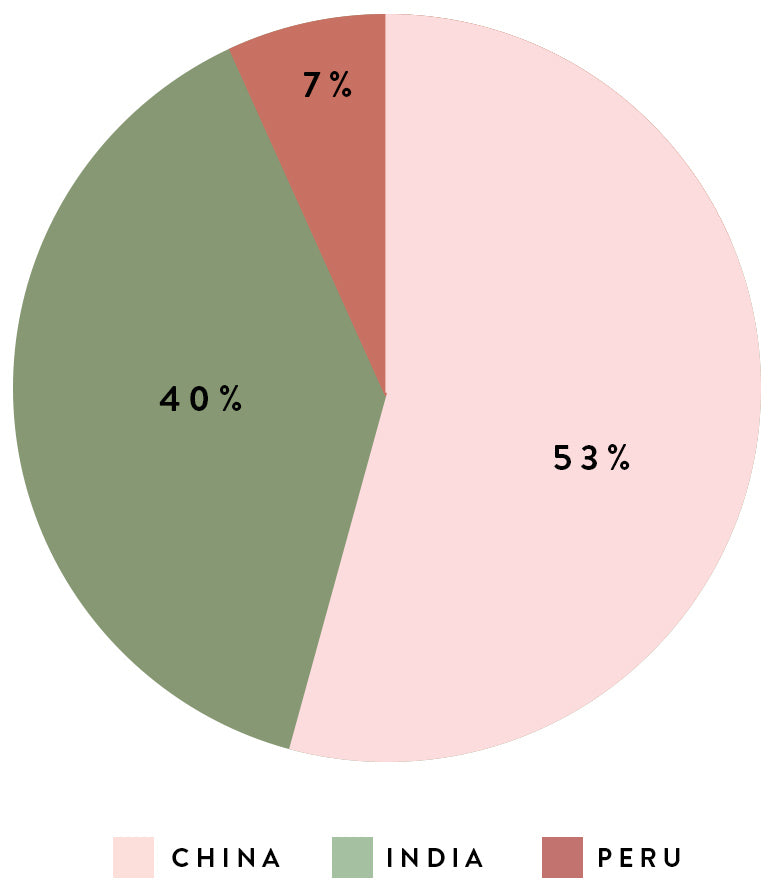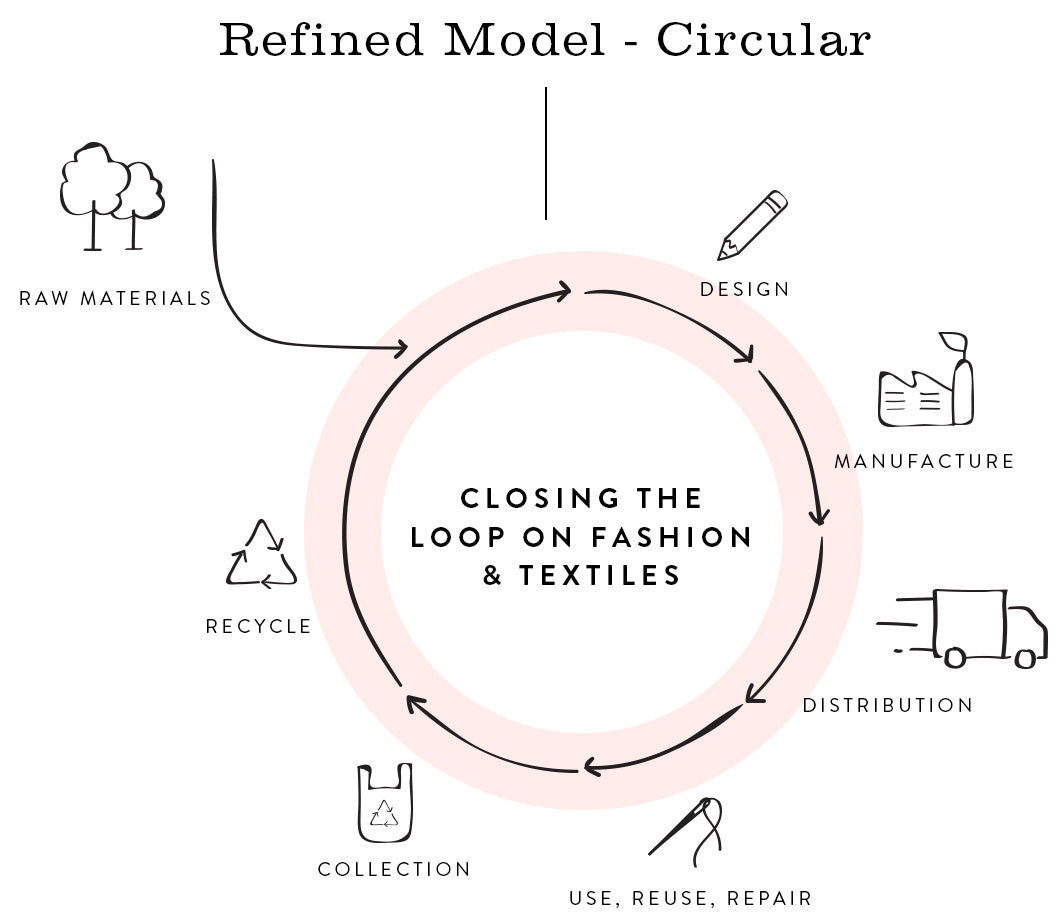OUR LATEST IMPACT REPORT
A lot can happen in 12 months!
OUR LATEST IMPACT REPORT
A lot can happen in 12 months!
INTRODUCTION BY OUR CO-FOUNDER, ELIZABETH ABEGG:
Here we are in the first quarter of 2019, with so many exciting sustainability initiatives on the horizon! We’re still a long way from reaching our 2025 sustainability targets, but as we keep our eyes on 2025, it’s important to also look at what we have achieved over the past year.
In this report (which spans January to December 2018) we give you an insight into the complex challenges associated with how we do business and specifically our sustainability program. The below figures show both our victories and where we’ve fallen short and they help us identify where we need to focus resources in the future.
Measuring our impact is a crucial part of our sustainability journey. Through turning a microscope on our operations and being transparent with those who count (you guys!) we’re holding ourselves accountable and pushing ourselves further. Even though there are areas where we see much room for improvement, we are extremely proud to be measuring our impact and striving for continuous improvement.
Thank you for tuning in and taking the time to absorb all this data! Here we go...!
Lizzy Abegg
The details
Whilst sustainability is an important part of our journey, it is foremost a science and with science comes defined systems, methodologies, scopes, data, metrics and targets. In our quest to be as accountable as possible we will be sharing some of the more technical aspects of our Sustainability program. You’ll notice it’s more in depth than our 2017 impact report, this is because we had experts work with us to gather, analyse and report on the data.
Our program is based on continuous improvement and is periodically reviewed and amended in order to stay true to our original vision.
The following report has been independently verified by a 3rd party auditor, as per the CUA Sustainable Verified statement at the end of this page.
The SPELL Sustainability Program applies to the entire value chain as defined below:
It includes the entire flow of processes involved in the production and lifecycle of all products. Which enables us to understand the true costs (economic, environmental and social) of all business decisions.
So let us start looking at some of the impacts from 2018…
Deep Dive
1. Supply Chain Transparency
Deep Dive
1. Supply Chain Transparency
SUMMARY
A sustainable supply chain is built on traceability and accountability.
It means understanding where and how garments are made and using that information to empower our global partners to make more sustainable choices.
2018 SUPPLY CHAIN BREAKDOWN
In 2018, we partnered with 15 different suppliers (Tier 1) factories.
This represents over 2,946 employees in our direct global reach.
Here is the breakup of where our garments are made:
HOW DO WE MEASURE?
Ensuring the social / ethical well-being of our global family and manufacturing units has been our initial focus. We have a multifaceted system to ensure complete accountability and transparency of our supply chain.
Here is the breakdown:
- All Suppliers sign our Code Of Conduct which is based on International Labour Organisation (ILE) and Ethical Trade Initiative (ETI) principles.
- All Suppliers are required to have an approved accredited ethical/ social certification. Details of each supplier’s certification is here (link).
- If a supplier is unable to achieve certification, they have the opportunity to be independently audited to the COC. An accredited certification body will conduct the audit if necessary.
SA8000 is our social standard of choice and globally recognised as the benchmark for all social / ethical certification standards. Most importantly, it is the only standard that specifically examines whether a company provides works with the equivalent of a living wage.
With the addition of some new factories and a facility that moved locations and are conducting a new audit, we didn't hit our 100% ethically certified target.
Currently we have engaged these facilities, who have already locked in an audit for the upcoming quarter.
SUMMARY
2018 was the year of fibres and fabrics. We knew that close to ⅔ of a garments impact occurs at the raw materials stages, we made this our core sustainability focus. In 2018, our production was split up as follows:
HOW DO WE MEASURE?
We define "sustainably sourced" through a wide range of material specific indicators that include land usage, water / energy / raw material inputs, toxicity, water / carbon / waste footprints. Recyclability and biodegradability are used to choose specific fibres and fabrics. We use a variety of accredited certification schemes to ensure we are meeting the highest international standards relating to a fibre's social and environmental impact.
We have quantified data by calculating SKU's. A SKU is defined as each style, per colourway designed, not quantity / volume produced. Calculations exclude jewellery SKUs due to the different baseline measure of materials used (fibres vs metals).
Let's look at our major fibre types:
Cellulose Fibres (Forest Fibres)
HOW DO WE MEASURE?
o Fibres must be derived from companies who have been audited against the Canopy Style standard and achieve the highest ranking (score of 20-35).
How did we perform?
Natural – Cotton, Linen, Silk & Leather
The Global Textile Standard (GOTS) is our tool of choice. This ensures all social/ ethical and environmental criteria are assessed to the highest internal standards. The Organic Content Standard (OCS) is also utilised to ensure traceability of fibre throughout the supply chain. Specifically, for leather we look at the Leather Working Group to ensure environmentally responsible manufacturing.
How did we perform?
- Whilst leather only represents 2% of our overall production, we ensured 100% of leather was derived from Leather Working Group Approved tanneries.
- Whilst our R&D found alternatives to silk
(3% of our production), these are still in early stages of development and were not utilised in 2018 production.
Synthetic and Blends
HOW DO WE MEASURE?
Global Recycle Standard (GRS) and Recycled Claim Standard (RCS) ensure that synthetic fibres are made from recycled material.
How did we perform?
WHERE TO?
Our aim is to increase from 30% to 40% sustainably sourced for 2019
We will be making our ‘SPELL Sustainably Sourced’ guide available in 2019. This essentially rates our fibres into categories and provides specific information on what is required within the supply chain to be deemed sustainable.
SUMMARY
SPELL’s artisan program is aimed at supporting marginalised artisan and crafts people. It is based on the notion that people can live better lives when they have direct access to the global market.
HOW DO WE MEASURE?
All artisans are to be working via a Fair Trade certified organisation. This ensures the social criteria which is relevant to our code of conduct is being met.
Next, we examine the physical units/ number of artisans and time taken to measure advocacy impact.
WHERE TO?
We are aiming to maintain our current level of 2 artisan projects for 2019.
SUMMARY
Every second the equivalent of one garbage truck of textiles is dumped in landfill or burned. This is solely due to the existing textile linear model in which we take – make - dispose. Within this model we cannot effectively address the sustainability of raw material or waste stages, therefore exposing limitations within our own program.
Whilst redesigning the entire system is a little beyond us, we are committed to being part of a broader shift that integrates circularity throughout our industry.
HOW DO WE MEASURE?
- In line with 2017 Global Fashion Agenda (GFA) Circular Fashion Commitments, the most efficient change would be increasing the % of recycled content within our production. As above we utilise the GRS and RCS certification standards to confirm providence.
- We have used both SKU count and overall volume to quantify.
- Our second 2020 GFA commitment was aimed at changing the way our team approached designing, sourcing and production in line with circular design principles. This is assessed via a number of training sessions and % of the overall team trained.
- Additionally, developing initiatives in our value chain that were driven by the principles of circular fashion. And by this we are examining such factors as design, garment longevity, biodegradability and recyclability.
SUMMARY
We and the rest of the fashion sector owe the planet. It has provided everything to get us to where we are today. And yet the sector has one of the largest environmental footprints for any industry globally. Simply we need to reduce our impacts and do so via a universally accepted methodology in which brands can benchmark themselves against. Making this available to consumers reveals the true cost of fashion and something we are all for.
HOW DO WE MEASURE?
When we are talking footprints, we are
talking carbon emissions, water and waste.
OUR 2018 GOAL
Source all domestic electricity from renewable energy.
Report on scope 1 & 2 carbon emissions for all domestic operations as per the Australian system; The National Carbon Offset Standard.
Define footprint methodology for broader supply chain.
Eliminate all non-biodegradable packaging related to garment orders.
How did we perform?
CARBON
All electricity for domestic operations was sourced from local, renewable resources. (Shout out to Enova our energy supplier who is doing great things in our local community, and Zero Emissions Byron for trying to get our whole community on renewables!)
CARBON EMISSIONS (SCOPE 1 AND 2)
- Annual Domestic Consumption: 42.47t Co2
- Solar Offset 16.94t Co2
- Net Remaining sourced from Local renewable resources 25.93t Co2
WHAT DOES THIS ACTUALLY MEAN?
We generated 40% of our domestic electricity via solar The remaining 56% was all sourced from local renewable resources. Therefore, no fossil fuels were used in producing electricity for any of our domestic operations.
In everyday equivalence, ensuring 42.47t CO2 stays out of the atmosphere is the same as:
WASTE
Introduction of 100% Biodegradable LDPE garment bags
Cardboard (recycled) boxes only to be used when customer specifically requests.
Dyes and prints are an integral part of our aesthetic. Ensuring sustainable inputs and processes has major implications for our overall production’s footprint.
OUR 2018 GOAL
Engage consultant to help with our Restricted Substance List (RSL) strategy.
10 SKU’s to be 100% Botanically dyed
HOW WILL WE MEASURE?
It’s all about chemistry and we use the following tools:
Restricted Substance List (RSL)
GOTS certification
Bluesign certification
How did we perform?
Consultant engaged.
WHERE TO?
Our aim is to finalise the RSL in 2019.
Additionally, we want a clear implementation plan that incorporates a verification relating to compliance.
SPELL believes in giving back to the environment and communities which make this planet such an amazing and inspiring place. We contribute to a variety of organisations whose work benefits those in need, also causes we feel passionately about.
We have three philanthropic pillars:
- Local: contribute to and strengthen the social fabric of our local community
- International: be a responsible global citizen
- 1% for the Planet: conserving our planet.
HOW DO WE MEASURE?
We refer to the number of initiatives and dollars contributed.
OUR 2018 GOAL
2 Social or Environmental Initiatives
180k funds to distribute
How did we perform?
WHERE TO?
In 2019, we will look to increase this figure by a staggering 84%!!!
We are aiming to contribute 350K to philanthropic causes.
So how do these metrics fair for our commitments and 2025 vision. Here is a final summary:
So all in all we pretty happy with 2018 progress but we are determined to improve in 2019. If you want to learn more about what we have in store for 2019 and beyond, please visit our roadmap.
CUA concludes that all the stated claims and information in the 2018 SPELL IMPACT REPORT were proven to be accurate and true. Within the parameters of their internal Sustainability Program, the report was observed to successfully provide assurance to stakeholders on the production and traceability of their garments for the calendar year 2018. Therefore, within the above scope, CUA deems Spell to be 'SUSTAINABLE VERIFIED'.
FULL REPORT AVAILABLE UPON REQUEST
END NOTE: This report was written by Simon Butler (Peterson Australia) in conjunction with the Spell Sustainability Team. Peterson Australia is a sustainability consultancy whose core objective is to drive change within organisations. There are too many brands making unverified claims relating to sustainability so everything that is quantified, calculated and claimed in this report is audited and verified by an independent certification body.
From Simon
There is no greenwashing, no fluffy marketing or misleading information in this report. Sustainability data, metrics, goals, targets, victories and fails…. as it should be…. completely transparent. Despite some amazing progress, SPELL will certainly have to work hard to hit all the targets as set out in their seriously ambitious program. However, seeing such momentum and significant change (in a short period of time) I am positive the team will embrace the challenge.
Publisher: Simon Butler (Peterson Australia) & Spell Sustainability Team. January 2019
Auditor: Control Union Australia. March 2019









































